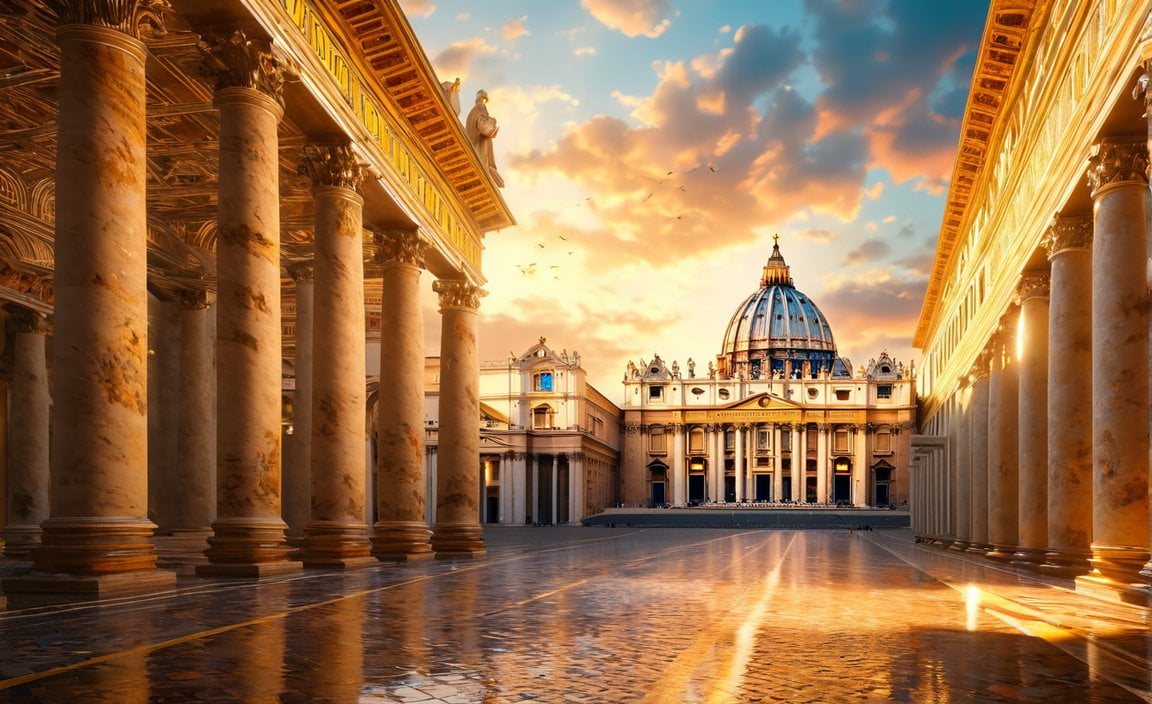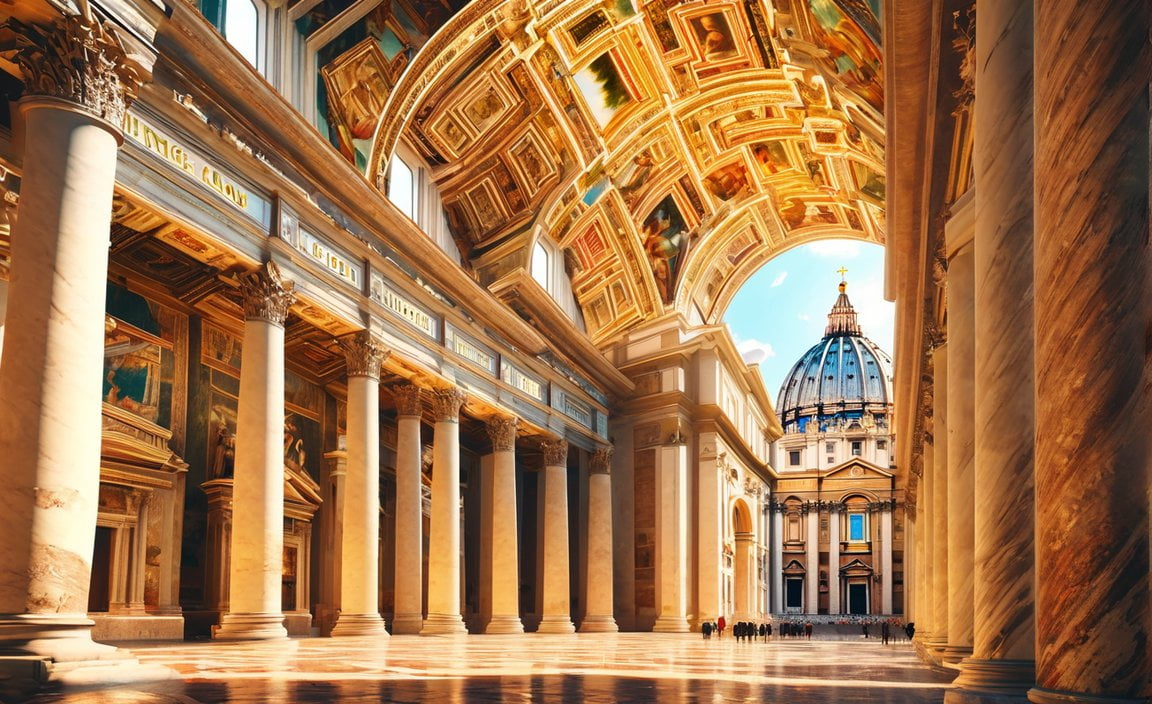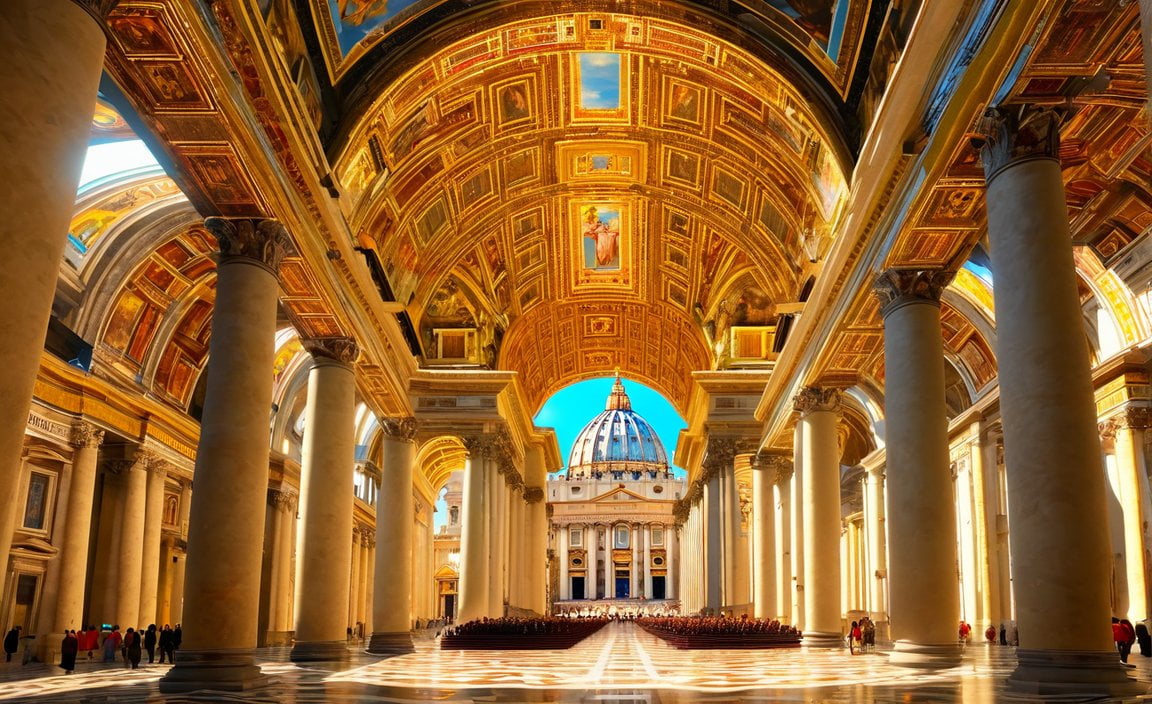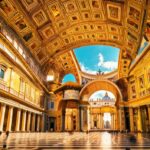Welcome to “Unveiling Vatican City: 5 Intriguing Facts”, where we delve into the lesser-known secrets of this captivating destination. With a keen eye for detail and a passion for uncovering unique information, we bring you a collection of surprising and fascinating facts about Vatican City. From its rich history and stunning art collections to its breathtaking landmarks, such as St. Peter’s Basilica and the Sistine Chapel, prepare to be enthralled by the treasures that this UNESCO World Heritage Site has to offer. So, let us begin our journey and discover the hidden wonders of Vatican City.

Key Takeaways:
- Vatican City is the smallest country in the world, covering just over 100 acres, about one-eighth the size of New York’s Central Park.
- Vatican City is the only country in the world that is situated inside a city, surrounded entirely by Rome.
- The Vatican is built on Saint Peter’s tomb, making it a significant religious site for Catholics worldwide. St. Peter’s Basilica, the largest Catholic church, is located at this site.
- Vatican City functions as an absolute monarchy, with the Pope serving as its ruler. The Pope is both the spiritual and temporal leader of the Catholic Church and the head of state of Vatican City.
- Unlike other countries, Vatican City has no official language. Italian is the most commonly used language for internal communications and official documents, while Latin is widely used for religious ceremonies and official acts.
5 Facts About Vatican City
Vatican City is a unique destination that intrigues visitors from all around the world. This tiny independent state, located within the city of Rome, holds a wealth of history and cultural treasures. Let’s explore five fascinating facts about Vatican City:
Fact 1: The Smallest Country in the World
Vatican City holds the distinction of being the smallest country on Earth. Covering just over 100 acres, it is about one-eighth the size of New York’s Central Park. Despite its small size, Vatican City boasts an immense cultural and religious significance that draws millions of tourists each year.
Fact 2: Inside a City
What makes Vatican City truly unique is its location – it is the only country in the world situated entirely inside a city. Surrounded by the bustling Italian capital of Rome, Vatican City stands as a distinct entity within its borders. It’s like a city within a city, offering visitors a captivating blend of architectural wonders and centuries of history.
Fact 3: Built on Saint Peter’s Tomb
The Vatican is more than just a political and religious center; it is a place deeply intertwined with Catholicism. Vatican City is built on the tomb of Saint Peter, one of the twelve apostles of Jesus Christ. Saint Peter’s Basilica, the largest Catholic church in the world, stands atop this sacred burial place. For Catholics, this site holds immense significance and draws pilgrims from all corners of the globe.
Fact 4: An Absolute Monarchy
Vatican City operates under a unique governance structure as an absolute monarchy. The Pope, who serves as the spiritual leader of the Catholic Church, also acts as the ruler of Vatican City. Known as the Bishop of Rome, the Pope holds both spiritual and temporal power within this independent state. This distinctive system of governance adds to the intrigue surrounding Vatican City.
Fact 5: No Official Language
Unlike most countries, Vatican City has no official language. While Italian is commonly used for internal communications and official documents, Latin takes center stage during religious ceremonies and official acts. This language diversity reflects the historical and religious roots of Vatican City.
With its small size, significant religious sites, and unique political structure, Vatican City offers a truly remarkable experience for travelers. Whether you are a history enthusiast, an art lover, or a pilgrim seeking spiritual connection, Vatican City has something for everyone.
So, have you ever wondered what it feels like to step into the world’s smallest country, nestled within the vibrant city of Rome? Now you know five fascinating facts about Vatican City that will surely entice you to explore this remarkable UNESCO World Heritage Site and its unparalleled treasures.
Here are some interesting facts about the Indus Valley Civilization that you might not know:
-
Did you know that the Indus Valley Civilization is one of the oldest urban civilizations in the world? Learn more about it here.
-
Explore the fascinating history of Prince Edward Island and discover 5 intriguing facts about this incredible place here.
-
Have you ever wondered what makes the African savanna so unique? Uncover 5 interesting facts about this diverse ecosystem here.
-
Delve into the lesser known facts about the Indus Valley Civilization and gain a deeper understanding of this ancient civilization here.
Feel free to click on the links and satisfy your curiosity!
Interesting Facts About Vatican City
Vatican City, the smallest country in the world, has a wealth of intriguing facts that make it a fascinating destination for travelers. Let’s dive into some of the most remarkable details about this unique independent state within Rome.
-
Size and Population: Vatican City occupies an incredibly compact area, covering approximately 0.17 square miles. With a population of just around 800 residents, it is also the smallest country in terms of both area and population^1^.
-
Historical Significance: The creation of Vatican City can be traced back to the Lateran Treaty of 1929, which established the sovereignty and independence of the Holy See within Rome. It marked a crucial turning point in the relationship between Italy and the Catholic Church^2^.
-
Distinction from the Holy See: While often used interchangeably, it’s important to note that Vatican City and the Holy See are not synonymous. The Holy See refers to the governing body of the Catholic Church, headed by the Pope, while Vatican City serves as its physical manifestation^2^.
-
Location Within Rome: One of the most captivating aspects of Vatican City is its unique status as the only country located entirely within a city, specifically Rome. This architectural peculiarity further adds to its allure and appeal^3^.
-
Languages Spoken: Although Vatican City does not have an official language, Italian and Latin are predominantly spoken by its residents. Italian is used for everyday communication, while Latin is employed for religious ceremonies and official acts^1^.
-
Gender Imbalance: With a population comprising mostly clergy and Swiss Guard members, the proportion of women residing in Vatican City is notably low, accounting for only 5.5%^2^.
-
Self-reliance: Despite its small size, Vatican City operates its own independent postal service, bank, radio station, and army. This level of self-sufficiency allows it to function autonomously within its borders^3^.
-
Capital and Area: The capital of Vatican City is none other than the Vatican City itself. Its area, as mentioned earlier, spans approximately 0.17 square miles, making it a true microstate^4^.
-
Enclave Country: Situated entirely within the borders of Italy, Vatican City stands out as one of the three enclave countries in the world. Its geographical placement further emphasizes its distinctive nature^3^.
-
Ruled by the Pope: As the spiritual head of the Catholic Church, the Bishop of Rome, also referred to as the Pope, has authority over Vatican City. This unique theocratic governance structure adds another layer of intrigue to the tiny country^4^.
-
Architectural Marvels: Vatican City boasts breathtaking architectural structures, including the world-renowned St. Peter’s Basilica and the Vatican Museums. These extraordinary landmarks house countless masterpieces of art and provide insights into the rich history and culture of the Catholic Church[^5^].
Key Takeaways:
- Vatican City is the smallest country both in terms of area and population.
- The creation of Vatican City can be traced back to the Lateran Treaty of 1929.
- Vatican City is distinct from the Holy See, which governs the Catholic Church.
- It is the only country located entirely within Rome.
- The residents primarily speak Italian and Latin.
- The gender ratio in Vatican City is heavily skewed, with women comprising only 5.5% of the population.
- Vatican City operates its own postal service, bank, radio station, and army.
- The capital of Vatican City is Vatican City itself.
- Vatican City is one of the three enclave countries in the world.
- The Bishop of Rome, known as the Pope, rules Vatican City.
- Notable architectural structures in Vatican City include St. Peter’s Basilica and the Vatican Museums.
Learn more:
– easyscienceforkids.com
– myadventuresacrosstheworld.com
Most Interesting Facts About Vatican City
As an experienced travel writer with a deep interest in religious sites, I have uncovered some intriguing facts about Vatican City, the world’s smallest country located within Rome. Let’s dive into the unique aspects of this independent state and discover what makes it so fascinating.
Vatican City: An Independent State Within Rome
-
Fact 1: Vatican City is the smallest country in the world, covering just over 100 acres, which is about one-eighth the size of New York’s Central Park. It is a sovereign state with its own independent government, separate from Italy.
-
Fact 2: Established in 1929 through the Lateran Treaty, Vatican City gained its independence as a result of an agreement between the Holy See and the Kingdom of Italy. This treaty recognized the Vatican as a self-governed entity.
-
Fact 3: Despite its small size, Vatican City has its own stamps, passports, license plates, and even its own internet domain (.va). These distinctive features highlight its status as an independent nation.
Unique Features and Characteristics
-
Fact 4: Vatican City does not have its own prison, hospital, or embassies, as it relies on the Italian institutions for these services. The absence of a prison signifies the peaceful nature of this small country.
-
Fact 5: Vatican City has its own national football team, participating in friendly matches and minor tournaments. Despite its limited resources, the Vatican team showcases the country’s passion for sports.
-
Fact 6: The entire population of Vatican City is Catholic, with 100 percent of its inhabitants practicing the Catholic faith. This religious homogeneity further emphasizes the Vatican’s significance as the spiritual heart of Catholicism.
-
Fact 7: While Vatican City does not have an official language, Italian is predominantly spoken within its borders. Latin, the language of the Roman Catholic Church, is used for religious ceremonies and official acts.
Citizenship and Currency
-
Fact 8: To become a citizen of Vatican City, one must be an employee or hold a specific appointment within the city-state. This requirement ensures that those who become citizens have a direct connection to the Vatican’s operations.
-
Fact 9: The official currency of Vatican City is the Euro, like in many other European countries. Visitors can use Euros for transactions within Vatican City, making it convenient for tourists from around the world.
Cultural and Historical Significance
-
Fact 10: St. Peter’s Basilica and the Vatican Museums are among the most renowned landmarks in Vatican City. St. Peter’s Basilica is the largest church in the world and home to stunning works of art, including Michelangelo’s masterpiece, the Pietà.
-
Fact 11: The Vatican City is a UNESCO World Heritage Site, recognized for its historical and spiritual significance. Its cultural treasures and architectural wonders have captivated visitors from all corners of the globe.
-
Fact 12: The Pope, as the Bishop of Rome, holds the highest authority in Vatican City. The Pope serves as the spiritual leader of the Catholic Church and plays a vital role in the governance of the city-state.
Key Takeaways:
- Vatican City is the smallest country in the world, encompassing just over 100 acres, and is an independent state within Rome.
- It was established in 1929 through the Lateran Treaty, solidifying its autonomy from Italy.
- Vatican City possesses its own stamps, passports, license plates, and internet domain.
- The country does not have its own prison, hospital, or embassies, relying on Italian institutions for these services.
- Vatican City has a national football team and its population is 100 percent Catholic.
- Italian and Latin are predominantly spoken within Vatican City.
- Citizenship is granted to employees or specific appointees within the city-state.
- The Euro is the official currency of Vatican City.
- St. Peter’s Basilica and the Vatican Museums showcase remarkable art collections and historical artifacts.
- Vatican City is recognized by UNESCO as a World Heritage Site due to its cultural and spiritual significance.
- The Pope, as the Bishop of Rome, holds the highest authority in Vatican City and is the spiritual leader of the Catholic Church.
Sources:
– Learn more: Vatican City Facts for Kids
– Learn more: 33 Fun Facts About Vatican City

FAQ
Q1: Is Vatican City the smallest country in the world?
A1: Yes, Vatican City is the smallest country in the world, covering just over 100 acres.
Q2: Where is Vatican City located?
A2: Vatican City is located within the city of Rome, Italy.
Q3: What is the historical significance of Vatican City?
A3: Vatican City is built on Saint Peter’s tomb, making it a significant religious site for Catholics around the world. It is also home to St. Peter’s Basilica and the Vatican Museums, which house priceless artworks and historical artifacts.
Q4: Who is the ruler of Vatican City?
A4: Vatican City is an absolute monarchy, with the Pope as its ruler. The Pope serves as the spiritual and temporal leader of the Catholic Church and the head of state of Vatican City.
Q5: What is the official language of Vatican City?
A5: Vatican City does not have an official language, but Italian is primarily used in internal communications and official documents, while Latin is widely used in religious ceremonies and official acts.
- Unveiling Bernhard Caesar Einstein’s Scientific Achievements: A Legacy in Engineering - July 15, 2025
- Uncover who is Jerry McSorley: CEO, Family Man, Business Success Story - July 15, 2025
- Discover Bernhard Caesar Einstein’s Scientific Contributions: Unveiling a Legacy Beyond Einstein - July 15, 2025















